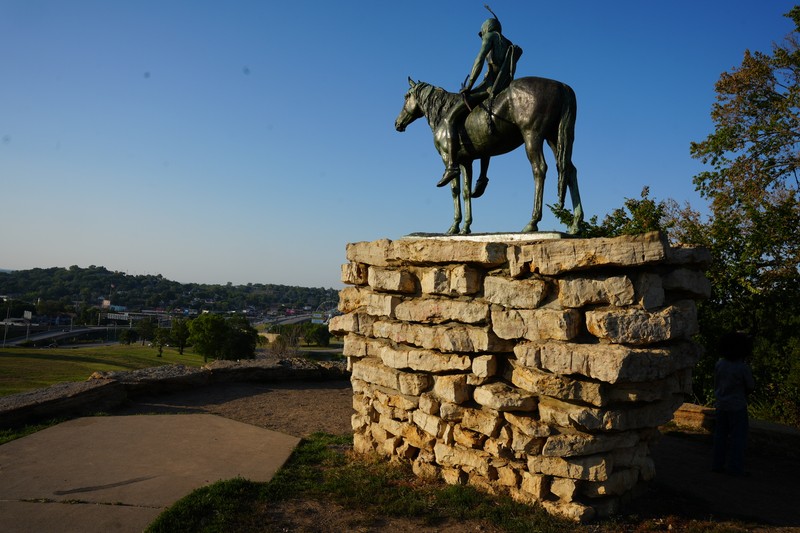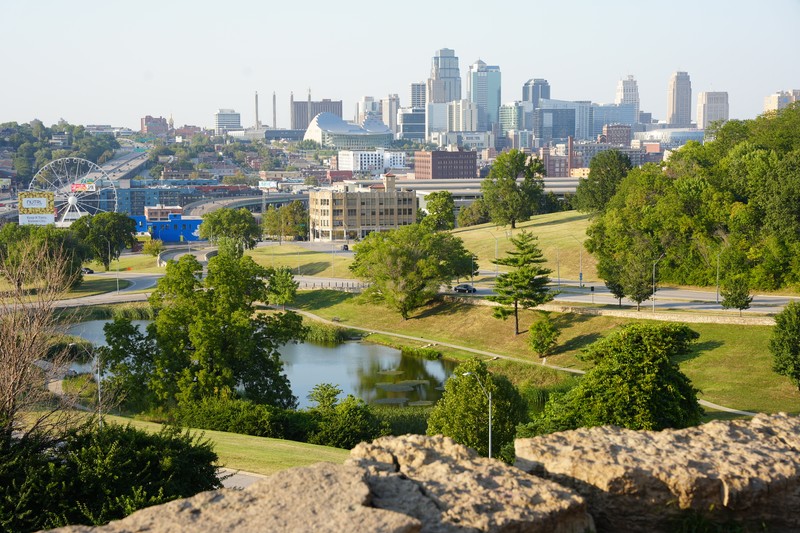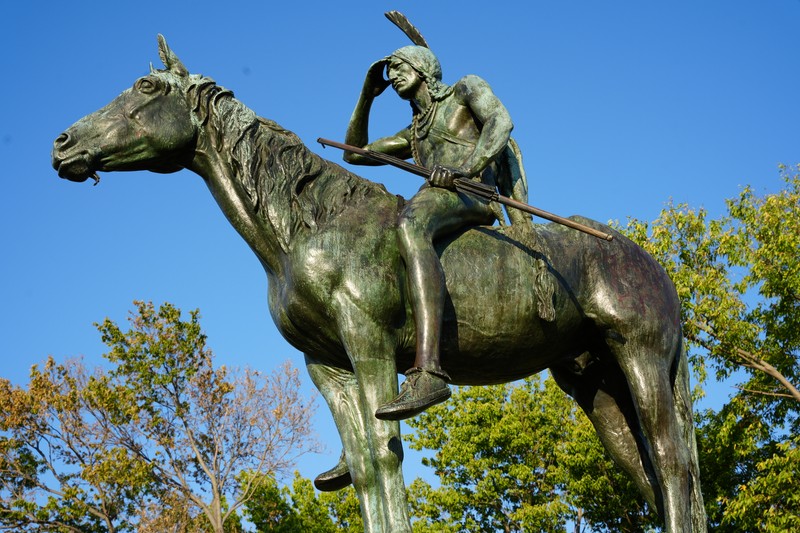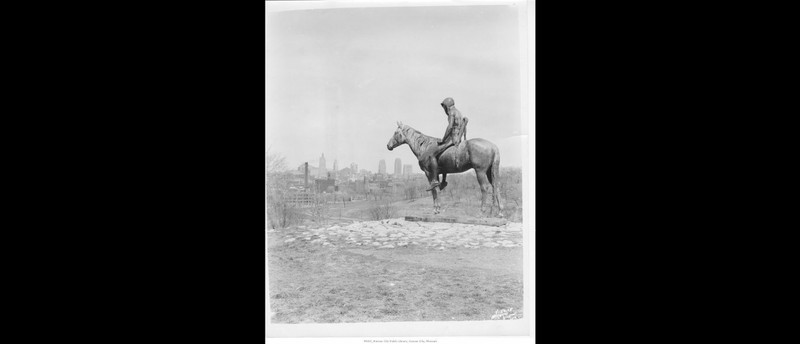The Scout
Introduction
Text-to-speech Audio
Sculptor Cyrus Dallin displayed this sixteen-foot bronze statue of a mounted Sioux Indian at San Francisco's 1915 Panama-Pacific International Exhibition. The sculpture was awarded the gold medal, leading to a cross-country tour of temporary installations that included Kansas City in 1916. In response to the statue's popularity, local newspaper editorials called for action, noting that the touring statue was for sale with a listed price of $15,000. Seventeen area organizations led efforts to raise funds, and local teachers worked with area school children to collect small donations, including nickels and dimes. Collectively, the efforts raised the needed funds to purchase and permanently display the sculpture. The effort was successful, with area residents contributing enough to purchase the statue and place it in Penn Valley Park. The Scout has been one of the symbols of Kansas City since its public dedication in 1922. In addition to this statue, one of four replicas of Dallin's statue of Wampanoag leader Massasoit can be found in Kansas City.
Images
View from the monument at dusk

View from the monument

The Scout by Cyrus Dallin was awarded the Gold Medal in the Panama-Pacific Exposition before finding a home in Kansas City

Postcard of The Scout statue in Penn Valley Park in 1918 when it was temporarily installed
.jpg)
This 1945 photo shows the feather and bow had been taken by vandals at some point

1922 photo after the Scout was acquired by the city. Notice Liberty Memorial under construction in the background
.jpg)
Backstory and Context
Text-to-speech Audio
Sculptor Cyrus Dallin was strongly influenced by the art and culture of Native American tribes in his native state of Utah. Prior to creating this statue, he created several other works that sought to capture the dignity and unique cultures of those tribes. In 1912, city leaders tried to raise funds to purchase a similar sculpture by Dallin. That statue, titled "Appeal to the Great Spirit," was on display at Boston's Museum of Fine Arts, and citizens of Boston raised the $12,000 needed to keep the statue in their city before fundraising efforts in Kansas City could reach the required amount.
Kansas City's Margaret Coburn had written letters in support of acquiring Coburn's statue in 1912, and she once again led efforts to acquire The Scout in 1916. Working with her father, banker James Coburn, they invited Cyrus Dallin to dinner and told them their hope to bring the Scout to Kansas City as a way of improving their odds of raising funds. Dallin approved the idea, and the statue was first displayed at 15th and Paseo, then a prominent location. The statue was then moved to Penn Valley Park, an idea that Margaret Coburn had back in 1912. In August 1916, Chief Little Bull, the son of the famous Sioux leader Sitting Bull, visited Kansas City and commented favorably about the authenticity of the artist's design. Dallin spent many years sketching Native Americans prior to making the statue, including many who were part of Buffalo Bill's touring show.
Many residents of Kansas City supported the effort to raise funds, but after several months, the Chamber of Commerce still had less than half of the needed amount. News that the Smithsonian was considering purchasing the statue inspired Ida Nelson, wife of publisher William Rockhill Nelson, to donate $1000 to the effort if the community could raise the remaining amount in two months. Two days later, the fundraising effort had reached its goal thanks to efforts by school children who collected dimes and nickels alongside larger donations from organizations and leading philanthropists. After the successful fundraising effort to purchase this statue, it quickly became one of the symbols of the city. City National Bank and Trust (UMB Bank today) added the Scout to its logo in the Great Depression. When a National Hockey League franchise was awarded to the city, the team was known as the Kansas City Scouts during their short tenure in the mid-1970s.
The statue has remained close to its original location over the past century, being placed between Penn Valley Park's lake and Summit Street. In 1921, the statue was moved around three hundred feet south, making its vantage point another 25 feet higher and offering a better view of the growing city. Although its base has changed, the statue has been vandalized and repaired numerous times. The first instance of vandalism occurred sometime in 1917, shortly after the statue made its Kansas City debut. The Kansas City Star reported the news that the arrow and bow had been stolen and placed the action in historical context: "Perhaps he [the vandal] thought the Sioux could not completely typify the American Indian until he bore the scars of the white man’s vandalism,' the 1917 article editorialized.
Acts of vandalism occurred throughout the 1920s, and despite efforts to discourage people from carving their initials into the side of the horse, this became a regular occurrence. By the 1930s, many considered moving the statue from the park to City Hall to prevent vandalism. The Parks Department regularly replaced missing portions of the statue, and there were numerous debates about moving the sculpture to a well-trafficked part of the city. In 1960, R. Crosby Kemper funded the construction of the stone pedestal base. The eight-foot base placed the bronze portion of the statue beyond the reach of ordinary vandals. As a visitor in the modern era will attest, the vandalism of the Scout's first decades has continued, with graffiti at the base being removed by the Parks Department at regular intervals.
Sources
Euston, Diane. The Scout in Penn Valley Park Stands as a Symbol on Kansas City's Skyline," Martin City Telegraph, Mach 27, 2022.
"The Scout." Kansas City Parks and Recreation. Accessed December 20, 2012. http://kcparks.org/attraction/the-scout.
Cole, Suzanne. The Scout: Still looking out for KC, Kansas City Star. . December 6th, 2010. Accessed September 2nd, 2024.
Hill, Kate . Scout out This KCQ, Kansas City Public Library. November 4th, 2020. Accessed September 2nd, 2024. https://kcpl.i8.dgicloud.com/blog/scout-out-kcq.
Photo by David Trowbridge
Photo by David Trowbridge
Photo by David Trowbridge
Missouri Valley Special Collections, Kansas City Public Library, Sam Ray Postcard Collection (SC58)
Missouri Valley Special Collections, Kansas City Public Library,
Missouri Valley Special Collections, Kansas City Public Library,
